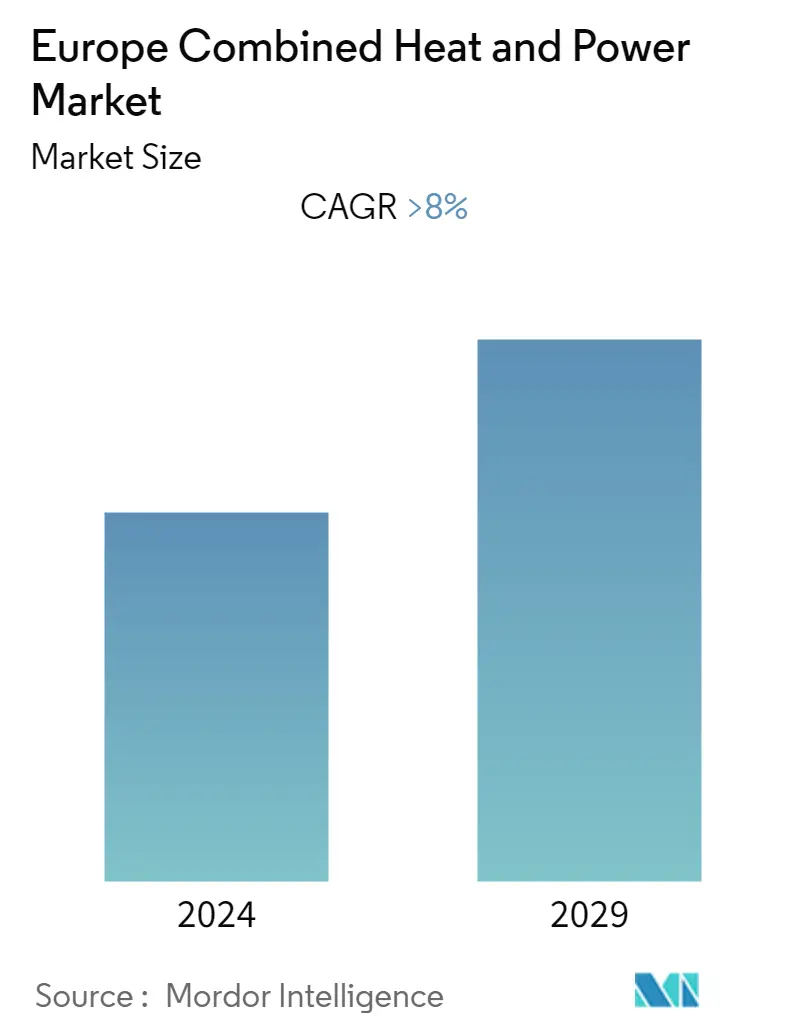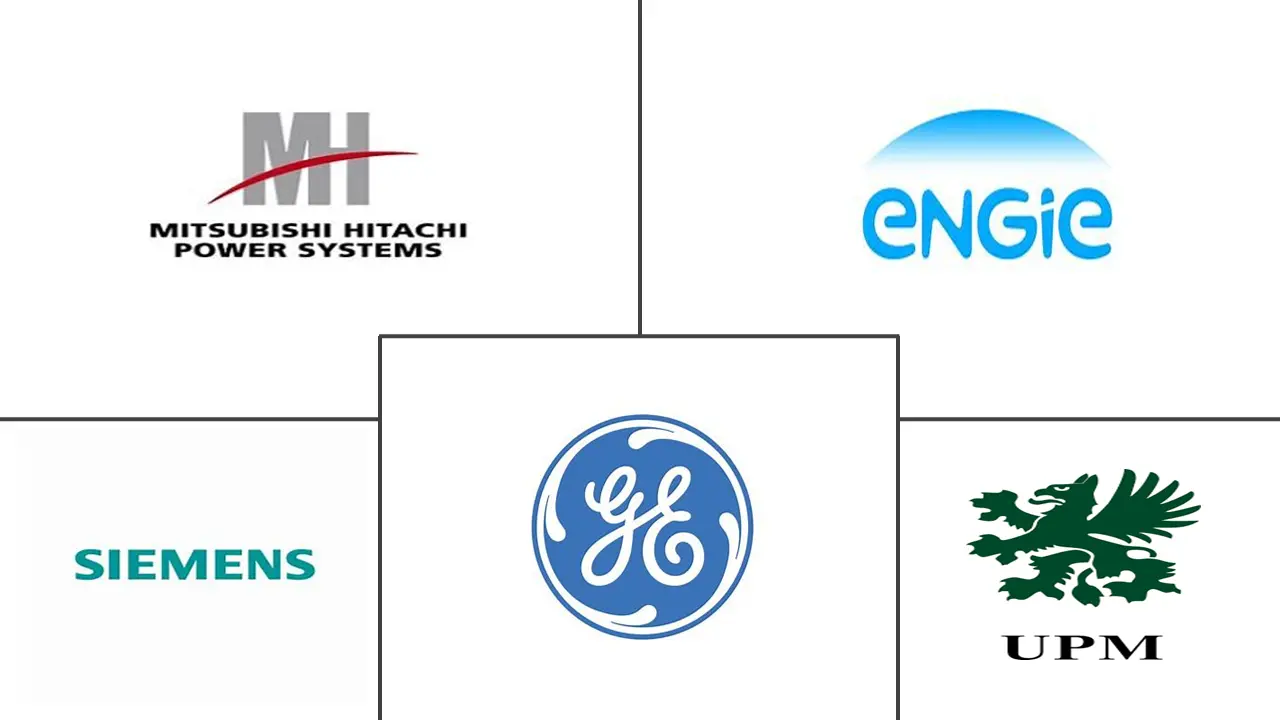Market Size of Europe Combined Heat and Power Industry

| Study Period | 2021 - 2029 |
| Base Year For Estimation | 2023 |
| Forecast Data Period | 2024 - 2029 |
| Historical Data Period | 2021 - 2022 |
| CAGR | > 8.00 % |
| Market Concentration | Medium |
Major Players
*Disclaimer: Major Players sorted in no particular order |
Europe Combined Heat and Power Market Analysis
Europe's combined heat and power market is expected to record a CAGR of over 8% during the forecast period.
The COVID-19 pandemic affected the market severely in 2020. Presently, the market has reached pre-pandemic levels.
- Over the medium term, the increasing energy demand, lowering energy costs, integration of renewable energy, and reducing carbon emissions are expected to drive the growth of the market studied.
- On the other hand, grid interconnection and significant initial capital investment are expected to hamper the growth of Europe's combined heat and power market during the forecast period.
- Nevertheless, increasing investment in the development of small-sized manufacturing units in the region will likely create lucrative growth opportunities for Europe's combined heat and power market during the forecast period.
- Germany dominates the market and is likely to witness the highest CAGR during the forecast period. This growth is attributed to the increasing investments and supportive government policies in the country.
Europe Combined Heat and Power Industry Segmentation
Combined heat and power (CHP) is a method to generate power by capturing heat produced through the generation process to provide thermal energy, e.g., steam or hot water. It is also known as a co-generation technology. CHP-generated energy is used for applications such as heating and cooling for domestic and industrial activities. CHP technique is regarded as eco-friendly compared to coal-fired power plants s ait uses sustainable energy sources such as biomass, natural gas, and residual waste.
The European combined heat and power market is segmented by application, fuel type, and geography. By application, the market is segmented into residential, commercial, industrial, and utility. By fuel type, the market is segmented as natural gas, coal, renewable, biomass, and other fuel types. The report also covers the market size and forecast for the European combined heat and power market. For each segment, the market sizing and forecasts have been done on revenue (USD billion).
| Applicaton | |
| Residential | |
| Commercial | |
| Industrial and Utility |
| Fuel Type | |
| Natural Gas | |
| Renewable | |
| Biomass | |
| Coal | |
| Other Fuel Types |
| Geography | |
| Germany | |
| United Kingdom | |
| Netherlands | |
| Rest of Europe |
Europe Combined Heat and Power Market Size Summary
The European combined heat and power (CHP) market is poised for significant growth, driven by increasing energy demand, cost reductions, and the integration of renewable energy sources. The market has rebounded to pre-pandemic levels after the setbacks caused by COVID-19. However, challenges such as grid interconnection issues and substantial initial capital investments could impede growth. Despite these hurdles, the development of small-sized manufacturing units presents promising opportunities for expansion. Germany stands out as a dominant player in the market, benefiting from robust investments and supportive government policies, which are expected to sustain its leading position and drive further growth.
The biomass sector has seen substantial growth, with biomass CHP technology offering a carbon-free solution for sites with consistent heat and electricity demands. Cogeneration currently plays a vital role in Europe's energy landscape, contributing significantly to electricity and heat production while aiding in the EU's CO2 reduction and energy efficiency targets. The contribution of CHP varies across European countries, with some nations like Denmark and Finland having a more substantial share. Germany's ambitious CHP targets and supportive policies have spurred investments, including large district heating networks and micro-CHP units. The market is moderately fragmented, with key players like 2G Energy AG, General Electric Company, and Siemens AG actively participating in the sector's development.
Europe Combined Heat and Power Market Size - Table of Contents
-
1. MARKET OVERVIEW
-
1.1 Introduction
-
1.2 Market Size and Demand Forecast in USD billion, till 2027
-
1.3 Recent Trends and Developments
-
1.4 Government Policies and Regulations
-
1.5 Market Dynamics
-
1.5.1 Drivers
-
1.5.2 Restraints
-
-
1.6 Supply Chain Analysis
-
1.7 Porter's Five Forces Analysis
-
1.7.1 Bargaining Power of Suppliers
-
1.7.2 Bargaining Power of Consumers
-
1.7.3 Threat of New Entrants
-
1.7.4 Threat of Substitute Products and Services
-
1.7.5 Degree of Competition
-
-
-
2. MARKET SEGMENTATION AND ANALYSIS
-
2.1 Applicaton
-
2.1.1 Residential
-
2.1.2 Commercial
-
2.1.3 Industrial and Utility
-
-
2.2 Fuel Type
-
2.2.1 Natural Gas
-
2.2.2 Renewable
-
2.2.3 Biomass
-
2.2.4 Coal
-
2.2.5 Other Fuel Types
-
-
2.3 Geography
-
2.3.1 Germany
-
2.3.2 United Kingdom
-
2.3.3 Netherlands
-
2.3.4 Rest of Europe
-
-
Europe Combined Heat and Power Market Size FAQs
What is the current Europe Combined Heat and Power Market size?
The Europe Combined Heat and Power Market is projected to register a CAGR of greater than 8% during the forecast period (2024-2029)
Who are the key players in Europe Combined Heat and Power Market?
General Electric Company , Siemens AG , Mitsubishi Hitachi Power Systems Europe, Ltd. , Engie SA and UPM are the major companies operating in the Europe Combined Heat and Power Market.

